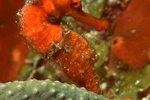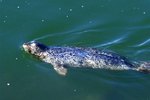
Comb jellyfish look unlike common sea jellyfish whose stinging tentacles dangle from frosted umbrella-top heads. In fact, comb jellies aren't true jellyfish at all; they're gelatinous creatures known as lobate ctenophores. Comb jellies lack the tentacles and muscular contractions of of sea jellies; they move instead by way of several rowing lanes of small cilia that line their bodies like combs. By the end of 2007, about 150 different varieties of comb jellies had been identified in oceans all over the world.
Habitat and Range
Comb jellies live in a variety of seascapes and tolerate a wide range of conditions pertaining to salinity, temperature, oxygen levels and general water quality. Although shallow coastal saltwater bodies such as estuaries and bays seem to be habitats of choice, comb jellies can be found everywhere from polluted, brackish inland waters to open oceans far away from any kind of terra firma. When the weather turns bad, comb jellies will descend into the ocean depths to avoid rough waters.
Manmade Nursuries
Young jellyfish polyps require solid, sturdy surfaces on which to settle and grow. to move through the polyp phase. Oddly enough, industrial intrusion upon the ocean by humans, "ocean sprawl" in the form of docks, oil platforms, drilling stations and other underwater constructions provides the perfect habitat in which animals like comb jellies can reproduce and their young mature.
The Effect of Climate Change
As oceans react to climate change, so do comb jellies. Specifically, comb jelly habitat ranges widen in scope as waters around the planet continue to warm. These temperature increases might help comb jelly embryos and larvae to develop more rapidly and in turn boost their species' population numbers. As such, comb jellies who are drawn to warm waters have far more options regarding where around the world they might live. On the other hand, cold-water comb jelly populations, with fewer places to call home, will likely suffer.
Comb Jelly Invasions
During the 1980s, the largest variety of comb jellies, known as sea walnuts, arrived in the Black Sea by way of seagoing ships' ballast waters. The sea walnuts reproduced in seemingly exponential numbers, consuming the majority of the area's zooplankton, and causing native fish populations to starve and collapse. Comb jellies have since arrived in the Caspian and Baltic seas, as well as along the coasts of Sweden. As of 2013, the American comb jelly was listed by the Global Invasive Species Program among the World’s Worst Invasive Alien Species.
References
- Open Guide to Pacific Marine Invertebrates: Julian Russell
- Aquarium of the Pacific: Online Learning Center: Comb Jellies
- Ocean Portal: Jellyfish and Comb Jellies
- Global Invasive Species Database: 100 of the World's Worst Invasive Alien Species
Resources
Photo Credits
-
Jupiterimages/Photos.com/Getty Images
Writer Bio
Ruth Nix began her career teaching a variety of writing classes at the University of Florida. She also worked as a columnist and editorial fellow for "Esquire" magazine. In 2012, Nix was featured in the annual "Best New Poets" anthology and received the Calvin A. VanderWerf Award for excellence in teaching from the University of Florida.




